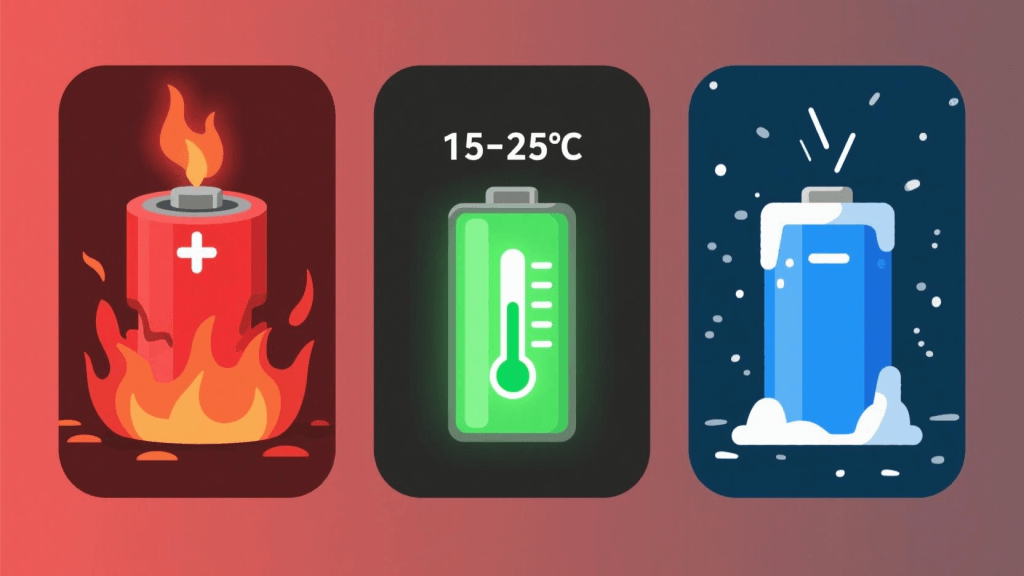With the increasing adoption of solar energy storage systems, proper battery maintenance has become critically important. Battery performance directly impacts system efficiency and lifespan. Many users neglect maintenance, leading to premature battery degradation and increased long-term costs. Mastering maintenance techniques helps extend service life and improve return on investment.
1. Key Factors Affecting Battery Lifespan
Temperature is the core factor influencing battery lifespan. High temperatures accelerate capacity degradation, while low temperatures reduce discharge capability. The ideal operating range is 15-25°C.
Charge-discharge cycles significantly impact longevity. Deep discharges damage batteries, whereas partial cycles are healthier. Lithium-ion and LiFePO4 (lithium iron phosphate) batteries are widely adopted for their performance and safety. Environmental factors like humidity and dust also require attention—adequate ventilation and clean environments are essential for sustained performance.

2. Professional Maintenance Techniques
- Temperature Management: Monitor temperatures and maintain within optimal range; install cooling/heating equipment when necessary.
- Charge Control: Avoid overcharging and deep discharging; limit Depth of Discharge (DoD) to <80%.
- Regular Cleaning: Clean battery casings and terminals quarterly; ensure ventilation ports remain unobstructed.
- System Updates: Timely update BMS (Battery Management System) software to optimize charge/discharge algorithms.
- Environmental Maintenance: Keep installation areas dry and clean to prevent humidity/dust accumulation.
3. Seasonal Maintenance Strategies
| Season | Maintenance Focus | Recommended Actions |
|---|---|---|
| Spring | Comprehensive Inspection | Inspect battery casing/ventilation ports; remove dust; implement moisture protection. |
| Summer | High-Temperature Management | Enhance ventilation/add cooling systems; adjust charging parameters; clean heat sinks regularly. |
| Autumn | Winter Preparation | Inspect insulation; clear debris; calibrate system parameters for low temperatures. |
| Winter | Low-Temperature Protection | Increase charging voltage appropriately; utilize heating devices; minimize deep discharges; verify insulation. |
4. Common Issues: Diagnosis & Resolution
| Symptom | Potential Causes | Recommended Solutions |
|---|---|---|
| Incomplete Charging/Rapid Discharge | Capacity degradation, frequent deep discharges, outdated software | Reduce DoD (<80%); review BMS logs; test/replace if significant capacity loss. |
| Temperature Anomalies (High/Low) | Inadequate cooling, extreme ambient temperatures, improper power settings | Optimize ventilation; avoid heat sources/extreme cold; inspect fans/heaters; adjust current. |
| Communication/Monitoring Failure | Loose connections, module failure, firmware incompatibility | Check cables/interfaces; reboot system; update firmware. |
| Persistent Alarms/Buzzers | Voltage/temperature/short-circuit triggers activating protection mode | Read error codes; verify abnormal parameters; avoid forced restarts; contact support if needed. |
| System Unresponsiveness/Frequent Rebooting | BMS malfunction, inverter errors | Power-cycle system; troubleshoot BMS/inverter; replace control modules if required. |
💡 Recommendation: Review operational logs monthly and utilize remote monitoring apps to preempt risks and ensure system stability.
5. Lifespan Assessment & Replacement Guidelines
🔍 How to Determine End-of-Life Status?
| Indicator | Normal Status | Problem Indicators |
|---|---|---|
| Remaining Capacity | ≥80% of rated capacity | ≤70%; noticeable runtime reduction |
| Internal Resistance | Stable | Increased resistance; reduced efficiency; overheating |
| Charging Duration | Consistent | Significantly prolonged; reduced current absorption |
| Voltage Fluctuation | Stable output | Frequent fluctuations affecting load stability |
| Alarm Frequency | Rare/None | Recurrent low-voltage/high-temperature warnings |
💡 Tip: Use BMS historical data and alarm logs to assess battery health.
6. Summary & Professional Recommendations
Solar batteries are the core of energy storage systems, with their health directly determining system efficiency and longevity. Through proper temperature control, scientific charge/discharge management, environmental maintenance, and regular inspections, users can effectively extend battery life and reduce maintenance costs.
We recommend leveraging smart monitoring systems for real-time status tracking and prompt anomaly resolution. When capacity degrades significantly or alarms occur frequently, battery replacement should be considered to ensure system safety and reliability.
Looking ahead, intelligent BMS and remote monitoring technologies will enhance operational efficiency. Systems equipped with health prediction capabilities will provide stronger protection for green energy assets.
